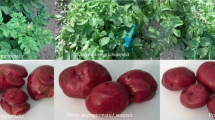Abstract
Russet Burbank, Russet Norkotah, and Shepody tubers infected with Potato virus Y strains (PVYO, PVYN:O, PVYNTN) were tested from storage at 4°C at the initiation of sprouting and then the same tubers were tested again from storage at 4°C seventy eight days later. Samples were taken from eyes in the stem, middle, and bud (distal end) areas of the tubers. Testing of the samples was done with an enzyme-linked immunosorbent assay (ELISA) and negative samples were retested using reverse transcription-polymerase chain reactions (RT-PCR). The ELISA alone and the ELISA+PCR combined results were evaluated for each of the strains, sample locations, sample time, and cultivar. Results show that ELISA underestimated the actual percentage of tubers with virus. When test results were combined to show a more accurate percentage, PVYN:O was unevenly distributed in some cultivars, but PVYO and PVYNTN were evenly distributed 78 days after initial sprouting. Results show that protocols for PVY post-harvest testing used by state seed certification agencies should be written to specify the amount of time needed before sampling and that specific protocols may be needed based on cultivar in order to accurately detect PVY in tuber samples.
Resumen
De un almacenamiento a 4°C, se probaron tubérculos de las variedades Russet Burbank, Russet Norkotah y Shepody, infectados con el virus Y de la papa variantes PVYO, PVYN:O, PVYNTN, para inicio de la brotación, y después, los mismos tubérculos se probaron otra vez de almacenamiento a 4°C setenta y ocho días mas tarde. Las muestras se tomaron de los ojos de las áreas del tallo, en medio, y ápice (extremo distal) de los tubérculos. Las pruebas se hicieron con un ensayo de inmunoabsorción enzimática (ELISA) y se probaron muestras negativas usando reacción en cadena de la polimerasa de transcripción inversa (RT-PCR). Se evaluaron la ELISA sola y los resultados combinados de ELISA+PCR para cada una de las variantes, localidades de la muestra, tiempo de la muestra y variedad. Los resultados muestran que la ELISA subestimó el porcentaje actual de tubérculos con virus. Cuando se combinaron los resultados de las pruebas para mostrar un porcentaje mas preciso, PVYN:O se distribuyó mas desuniformemente en algunas variedades, pero PVYO y PVYNTN estuvieron distribuidos uniformemente después de 78 días de la brotación inicial. Los resultados muestran que los protocolos para las pruebas de PVY de postcosecha utilizados por las agencias estatales de certificación de semilla deberían estar por escrito para especificar la cantidad de tiempo requerido antes del muestreo y que los protocolos específicos serán necesarios basados en la variedad, a fin de detectar con precisión PVY en muestras de tubérculo.

Similar content being viewed by others
References
Bolotova, Y.V., A.V. Karasev, and C.S. McIntosh. 2009. Statistical analysis of the laboratory methods used to detect potato virus Y. American Journal of Potato Research 86: 265–271.
Crosslin, J.M., P.B. Hamm, K.C. Eastwell, R.E. Thornton, C.R. Brown, D. Corsini, P.J. Shiel, and P.H. Berger. 2002. First report of the necrotic strain of Potato virus Y (PVYn) on potatoes in the northwestern United States. Plant Disease 86: 1177.
Crosslin, J.M., P.B. Hamm, D.C. Hane, J. Jaeger, C.R. Brown, P.J. Shiel, P.H. Berger, and R.E. Thornton. 2006. The occurrence of PVYO, PVYN, and PVYN:O strains of Potato virus Y in certified potato seed lot trials in Washington and Oregon. Plant Disease 90: 1102–1105.
de Bokx, J.A., and C. Cuperus. 1987. Detection of potato virus Y in early-harvested potato tubers by cDNA hyrbridization and three modifications of ELISA. OEPP/EPPO Bulletin 17: 73–79.
Fox, A., F. Evans, and I. Browning. 2005. Direct tuber testing for Potato Y potyvirus by real-time RT-PCR and ELISA: reliable options for post-harvest testing? EPPO Bulletin 35: 93–97.
Gray, S., S. De Boer, J. Lorenzen, A. Karasev, J. Whitworth, P. Nolte, R. Singh, A. Boucher, and H. Xu. 2010. Potato virus Y: An evolving concern for potato crops in the United States and Canada. Plant Disease 94: 1384–1397.
Gugerli, P., and W. Gehriger. 1980. Enzyme-linked immunosorbent assay (ELISA) for the detection of potato leafroll virus and potato virus Y in potato tubers after artificial break of dormancy. Potato Research 23: 353–359.
JMP. 2006. Statistical discovery. Version 6. Cary: Statistical Analysis System Institute Inc.
Lorenzen, J.H., N.C. Gudmestad, T. Meacham, and P. Shiel. 2006. A multiplex PCR assay to characterize Potato virus Y isolates and identify strain mixtures. Plant Disease 90: 935–940.
McDonald, J.G., and W.K. Coleman. 1988. A reevaluation of bromoethane in comparison to rindite for the post-harvest detection of potato virus Y in tubers by ELISA. American Potato Journal 65: 547–550.
McDonald, J.G., and G.T. Kristjansson. 1993. Properties of strains of Potato virus YN in North America. Plant Disease 77: 87–89.
Nie, X., and R.P. Singh. 2002. A new approach for the simultaneous differentiation of biological and geographical strains of Potato virus Y by uniplex and multiplex RT-PCR. Journal of Virological Methods 104: 41–54.
PAA, 2011. Varieties found to be latent to PVY. Accessed at http://oregonstate.edu/potatoes/PAA-Latent%20Varieties.htm. Accessed 29 September 2011.
Singh, M., and R.P. Singh. 1996. Factors affecting detection of PVY in dormant tubers by reverse transcription polymerase chain reaction and nucleic acid spot hybridization. Journal of Virological Methods 60: 47–57.
Singh, R.P., J.P.T. Valkonen, S.M. Gray, N. Boonham, R.A.C. Jones, C. Kerlan, and J. Schubert. 2008. Discussion paper: The naming of Potato virus Y strains infecting potato. Archives of virology 153: 1–13.
Vetten, H.J., U. Ehlers, and H.L. Paul. 1983. Detection of potato viruses Y and A in tubers by enzyme-linked immunosorbent assay after natural and artificial break of dormancy. Phytopathologische Zeitschrift 108: 41–53.
Acknowledgements
The authors thank Penny Tubbs, Darren Hall, Melinda Bateman, Melissa Bertram, and Jill Randall for their assistance in conducting this research. This work was partially funded by the USDA/CREES Special Potato Grant Program.
Author information
Authors and Affiliations
Corresponding author
Rights and permissions
About this article
Cite this article
Whitworth, J.L., Hamm, P.B. & Nolte, P. Distribution of Potato virus Y Strains in Tubers during the Post-Harvest Period. Am. J. Pot Res 89, 136–141 (2012). https://doi.org/10.1007/s12230-012-9235-6
Published:
Issue Date:
DOI: https://doi.org/10.1007/s12230-012-9235-6




